
Stained glass is coloured glass as a material or works created from it. Throughout its thousand-year history, the term has been applied almost exclusively to the windows of churches and other significant religious buildings. Although traditionally made in flat panels and used as windows, the creations of modern stained glass artists also include three-dimensional structures and sculpture. Modern vernacular usage has often extended the term "stained glass" to include domestic lead light and objets d'art created from foil glasswork exemplified in the famous lamps of Louis Comfort Tiffany.
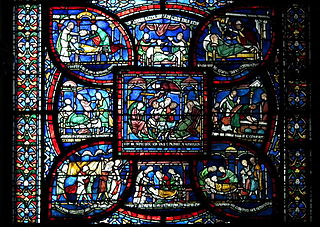
Came glasswork is the process of joining cut pieces of art glass through the use of came strips or foil into picturesque designs in a framework of soldered metal.

Conrad Schmitt Studios is an architectural arts studio located in New Berlin, Wisconsin. It provides ecclesiastical art, stained glass artistry, art glass, decorative painting, mosaics, murals and sculptural arts. The studio specializes in restoration services for buildings of architectural, historical and religious significance. Founded in 1889 by German-American artist Conrad Schmitt, the company is one of the oldest and largest glass studios in the United States.

Leadlights, leaded lights or leaded windows are decorative windows made of small sections of glass supported in lead cames. The technique of creating windows using glass and lead came to be known as came glasswork. The term 'leadlight' could be used to describe any window in which the glass is supported by lead, but traditionally, a distinction is made between stained glass windows and leadlights; the former is associated with the ornate coloured-glass windows of churches and similar buildings, while the latter is associated with the windows of vernacular architecture and defined by its simplicity.

A revival of the art and craft of stained-glass window manufacture took place in early 19th-century Britain, beginning with an armorial window created by Thomas Willement in 1811–12. The revival led to stained-glass windows becoming such a common and popular form of coloured pictorial representation that many thousands of people, most of whom would never commission or purchase a painting, contributed to the commission and purchase of stained-glass windows for their parish church.

Christopher Whitworth Whall was a British stained-glass artist who worked from the 1880s and on into the 20th century. He is widely recognised as a leader in the Arts and Crafts movement and a key figure in the modern history of stained glass.

Sarah Hall is a stained glass artist from Canada. Sarah Hall is internationally recognized for her large-scale art glass installations and solar projects. Her work can be found in churches, synagogues, schools, and other commercial and public buildings in Canada, the US, and Europe.

McCartney Library is an academic library located on the campus of Geneva College in Beaver Falls, Pennsylvania, United States. The building is named after the influential evangelical minister Dr. Clarence E. Macartney who grew up in Fern Cliffe House when the college moved to Beaver Falls in 1880.

William Willet was an American portrait painter, muralist, stained glass designer, studio owner and writer. An early proponent of the Gothic Revival and active in the "Early School" of American stained glass, he founded the Willet Stained Glass and Decorating Company, a stained glass studio, with his wife Anne Lee Willet, in protest against the opalescent pictorial windows which were the rage at the turn of the twentieth century.
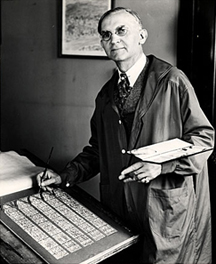
Charles Jay Connick (1875–1945) was a prominent American painter, muralist, and designer best known for his work in stained glass in the Gothic Revival style. Born in Springboro, Pennsylvania, Connick eventually settled in the Boston area where he opened his studio in 1913. Connick's work is contained in many preeminent churches and chapels, including examples in Boston, Chicago, Detroit, New York City, Pittsburgh, San Francisco, Seattle, and Washington, D.C. He also authored the book Adventures in Light and Color in 1937. Connick's studio continued to operate, and remained a leading producer of stained glass, until 1986.
Dieterich Spahn was a German-born American artist working in the fields of stained glass and painting. In a career spanning more than four decades he produced roughly 370 stained glass commissions for places of worship, hospitals, universities and private residences throughout the United States. In addition to stained glass, Spahn continues to explore new media and techniques with his painting.

Lawrence Stanley Lee was a British stained glass artist whose work spanned the latter half of the 20th century. He was best known for leading the project to create ten windows for the nave of the new Coventry Cathedral. His other work includes windows at Guildford and Southwark Cathedrals as well as a great number of works elsewhere in the UK, and some in Canada, Australia and New Zealand.
Peter Mollica is an American stained glass artist.
Dalle de verre, from French: "glass slab", is a glass art technique that uses pieces of coloured glass set in a matrix of concrete and epoxy resin or other supporting material.
Jean-Jacques Duval was a French-born American artist who pioneered abstract art and the use of faceted glass in stained glass design in the 1960s. In 2005 he was awarded the Lifetime Achievement Award by the Stained Glass Association of America. Best known for his window designs in Germany, Israel, Japan, the West Indies, and the United States, his paintings and sculptures have also been exhibited throughout North America.

Nicola D'Ascenzo was an Italian-born American stained glass designer, painter and instructor. He is best known for creating stained glass windows for the Washington Memorial Chapel in Valley Forge, Pennsylvania; the Nipper Building in Camden, New Jersey; the Loyola Alumni Chapel of Our Lady at Loyola University Maryland; the Folger Shakespeare Library and Washington National Cathedral, both in Washington, D.C.
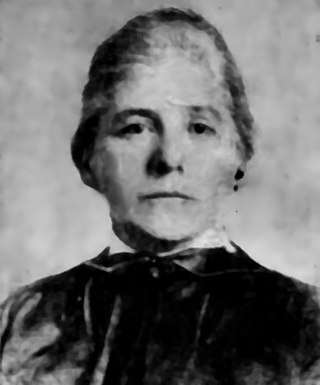
Margaret Redmond (1867–1948) was an American stained glass artist. Her work is characteristic of the medieval revival style, inspired by the fourteenth and fifteenth century stained glass of French and English cathedrals. She chose innovative glass materials, vibrant colors and thick leading designs for her windows, favored by the leading stained glass artists of the Arts and Crafts Movement in England. She is best known for her stained glass work from the 1920s to the 1940s, which can be found in churches, museums, homes and libraries from New Jersey to Maine.
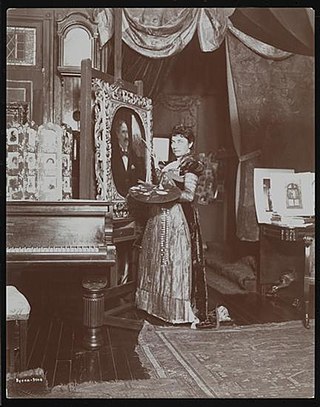
Mary Elizabeth Tillinghast was an American artist. Best known for stained glass, her professional career encompassed roles as architect, muralist, mosaic artist, textile artist, inventor, writer, and studio boss.

Robert Sowers was an American painter, photographer, stained glass artist, and seminal figure in the re-emergence of stained glass as an architectural art in the United States. His architectural glass commissions cover some 20 years from St George's Episcopal Church, Durham, New Hampshire (1955) to Stephen Wise Free Synagogue, New York (1975) and the blue cross window for Cathedral of the Immaculate Conception. In November 1953 he participated in the New Talent Exhibition at the Museum of Modern Art in New York City. He designed the vast American Airlines terminal glass facade at John F. Kennedy International Airport in 1958–59. It was demolished in 2008 to allow for an reorganization and expansion of their terminal.
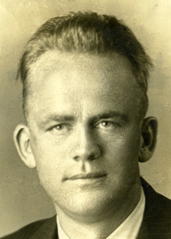
Carl Huneke was a German-American stained glass artist and master craftsman.

















